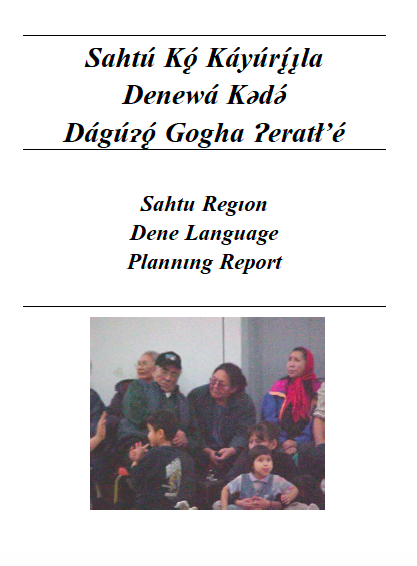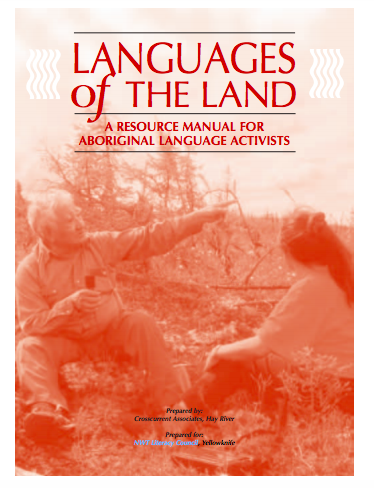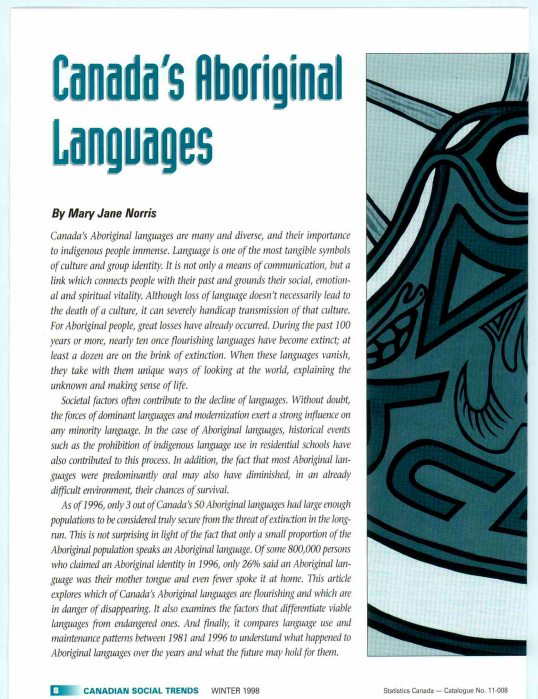Sahtú Kǫ́ Káyúrı̨́ı̨la Denewá Kedǝ́ Dágúɂǫ́ Gogha Ɂeratł’é: Sahtú Regıon Dene Language Plannıng Report
This bilingual Dene language plan (with Dene translations following English sections) was coordinated by the Sahtú Secretariat Incorporated (SSI) on behalf of the Government of the Northwest Territories, created in order to allow SSI access five-year government funding. The planning process consisted of extensive background research and a three-day language planning conference.
One key theme from the conference was that participants did not feel that North Slavey nor Sahtú Dene was an appropriate term for their language, because they did not feel it represented the diversity of peoples within the region. Therefore, the word Dene is used in general, accompanied with the more specific terms Sahtúot’ıne, K’ashogot’ıne, and Shútáot’ıne used when appropriate.
In 2000, 50% of the Sahtú population between the ages of 25 and 44 were fluent in their language, while 100% of those over 45 were fluent, suggesting a significant generational difference. Furthermore, less than 10% of the population 25 and younger were fluent. With regard to where Dene language is best used, workshop participants saw potential for “a bilingual Sahtú region with the Dene language being actively used in all areas of community life—in homes, in schools, at work, and in all social activities, especially land-based activities.” (3) This would be supported by a Sahtú Cultural Institute and self-determination.
The delegates also talked about language attitudes: Younger people were afraid to speak the language, for fear of being laughed at or criticized for poor language skills. Elders were worried about the language not being in the home. Changing lifestyles impact respect for language, though some still connect pride and identity with language.

Access this Resource:
Crosscurrent Associates. Sahtú Kǫ́ Káyúrı̨́ı̨la Denewá Kedǝ́ Dágúɂǫ́ Gogha Ɂeratł’é. Sahtú Regıon Dene Language Plannıng Report. Délı̨nę: Sahtú Secretarıat Incorporated Delı̨́ne, 2000.
Languages of the Land: A Resource Manual for Aboriginal Language Activists
This manual contains a number of useful tools for language revitalization, including a historical assessment of language shift in Canada and a language vitality chart. Regarding Dene Language, some useful facts and statistics are expressed in the section on the status of Aboriginal Languages in the Northwest Territories:
- The text lists the 1996 home-language to mother-tongue ratio for North Slavey as 59%. While it has 1986 data for the other official languages, it adds that North Slavey data “has only recently been gathered through the Canada census…. The results of the Census data from 1991 and 1996 are inconclusive with respect to language shift.” (20)
- A 1992 Language Report interviewed 160 people in Délı̨nę, Tulı́t’a, and Fort Good Hope, to determine that 63% of respondents learned North Slavey as a first language, 54% was their most fluent language, and 45% use it most frequently at home (20).
Access this Resource:
This resource is available on the NWT Literacy Council website.
Crosscurrent Associates. Languages of the Land: A Resource Manual for Aboriginal Language Activists. Yellowknife: NWT Literacy Council, 1999.
Northern Dene Bibliography (incomplete)
This 66 page list of social, cultural and linguistic sources is presented as a work in progress, and the author encourages people to contact him at This email address is being protected from spambots. You need JavaScript enabled to view it. to contribute to the list or be provided with updates (this was not done at time of writing). The list is organized by geographical areas, as well as topics. The geographical scope for each section is very broad, being divided into only two groups. The first section focuses on “Dene ("Chipewyan" - Northern SK and MB, NWT).” Resources related to the Sahtú are encompassed within a section entitled “Dene (B.C., AB, Yukon, NWT) … some Algonquian Sources.” Sections include: Social and Cultural (pages 18-39); Language (pages 40-42); Hearne Bibliography (pages 42-44); Resource Books (pages 44-47); University Dissertations (pages 47-66; this is the only section that includes abstracts).
Access this Resource:
http://northernwaterways.com/MYCCR/northern_dene_biblio.pdf
Labenski, Ed. Northern Dene Bibliography (incomplete). Chicago, University of Chicago. 1998.
Canada's Aboriginal Languages
Norris, writing in 1998, presents an overview of which Aboriginal Languages in Canada appear healthy and which are endangered, along with what factors contribute to language vitality. The paper uses data from 1981 to 1996 to examine language use and maintenance over time. This study recognizes 50 Indigenous languages in Canada under 11 language families. Additionally, Norris employs M. Dale Kinkade’s 1991 study “The Decline of Native Languages in Canada” in order to identify which languages are “already extinct, near extinction, endangered, viable but with a small population base, and viable with a large population.” (9)
From 1980 to 1996 across Canada, the number of people with an Aboriginal mother tongue increased by 24%; however, those using the language at home only increased by 60%, and the latter is more important for the index of continuity, particularly as average age of speaker continues to go up. 1996 data shows North Slavey with a mother tongue population of just 290. Norris shows that loss of language use (across Canada) occurs most often when youth leave the home and enter the workforce, particularly when entering large, urban environments. This is particularly true for women, for no immediately clear reason.
Access this Resource:
Norris' paper is available from Statistics Canada, and has also been uploaded on several University websites.
Norris, Mary Jane. “Canada’s Aboriginal Languages.” Canadian Social Trends. Statistics Canada Catalogue no. 11-008 (1998): 8-17.
Literacy in Athtapaskan languages in the Northwest Territories, Canada: For what purposes?
This text examines fluency and literacy in Northwest Territories Athapaskan languages. It provides an overview of literacy policy and trends therein, as well as the tension between literacy and oral language patterns.
Abstract:
Data on fluency and literacy in Athapaskan (Dene) languages in the Northwest Territories of Canada are reviewed here, with discussion of recent policy decisions regarding implied or explicit roles of Dene literacy and the forms they might take. Emphasis is placed on evidence of trends in Dene literacy development; special attention is given to the extent to which new roles for literacy are created, and to the extent to which literacy conforms to patterns consistent with oral language use. The context is the legitimacy of Dene cultures, languages, social practices, and economic and political power in the face of Euro-Canadian pressures.
Access this Resource:
DOI: https://doi.org/10.1075/wll.1.1.04bur
Burnaby, Barbara. “Literacy in Athapaskan languages in the Northwest Territories, Canada: For what purposes?” Written Language & Literacy 1, no. 1 (1998): 63-102.
Language in the Northwest Territories and the Yukon Territory
Harnum provides a brief history of and context for Indigenous languages in the NWT and Yukon Territory, as well as colonial governance and its history in the north, before turning to historical languages and shift (for example, the gradual erosion of the distinction between Yellowknives Dene and their neighboring languages and cultures). Next, the author turns to contemporary trends in the NWT legislature, curriculum development, and training programs.
Access this Resource:
Harnum, Betty. “Language in the Northwest Territories and the Yukon Territory.” In Language in Canada, edited by John Edwards, 469-82. Cambridge: Cambridge University Press, 1998.
Read Harnum's chapter in the Google Book Preview:
Life on the Edge: Canada’s Aboriginal Languages Under Official Bilingualism
This paper discusses the tension between official bilingualism and minority language rights in Canada. Its overview of the first decade of the Official Languages Act in the Northwest Territories highlights key strengths and opportunities for improvement in Official Languages policy.
Access this Resource:
Fettes, Mark. “Life on the Edge: Canada’s Aboriginal Languages Under Official Bilingualism” In Language and Politics in the United States and Canada: Myths and Realities, edited by Thomas K. Ricento and Barbara Burnaby, 117-149. Mahwah, N.J.: Lawrence Erlbaum, 1998.
Read Fettes' chapter in the Google Books preview.
Annual Report on Official Languages 1996-1997
Every fiscal year, the Government of the Northwest Territories issues a record of measures taken to implement the Official Languages Act. Each report details developments in both French and Aboriginal language programming. Many programs focus on connecting youth with elders, training teachers, developing curriculum, and providing government services in as many languages as possible.
From Introduction: “This report is available in French. It is also made available in other NWT Official Languages upon a reasonable request to: the Department of Education, Culture, and Employment. Language Services Section.” (1)
Notable events from this reporting year:
Dene Kede curriculum grades 7-9 was still in development at this time, through consultations with Elders and the committee. The draft version was piloted in the next fiscal year, “with field evaluations completed late in the 1997/98 fiscal year. Several teaching units were developed to support the curriculum.” (4)
Teaching and learning centres continued to develop in materials and programs, with DECs. Included “development of teaching kits in North Slavey (Traditional Dene Food Kit, Traditional Dene Games).” (5)
The Conclusion closes by recognizing the simultaneous importance of government services and the need for a larger community role “in the delivery of language services and programs, and the establishment of priorities for language development, that many NWT official languages will survive and may one day flourish again.” (20)
Access this Resource:
The Government of the Northwest Territories makes reports from the last decade available here: https://www.ece.gov.nt.ca/en/services/francophone-affairs-secretariat/official-languages-annual-reports. Older reports are archived with the Department of Education, Culture, and Employment.
Government of the Northwest Territories. Annual Report on Official Languages. Yellowknife: 1997.
The Indigenous Languages of the North: A Report on Their Present State
This paper discusses the state languages in the geopolitical North (in Greenland, Northern Canada, Alaska, Russia, and Saami) at the time of writing. Regarding North Slavey, which the author comments encompasses Hare, Bearlake, and Mountian, the paper provides a population estimate of 1,600 and approximates that 900 of those speak the language, including some children. The end of the paper provides these figures summarized in a table with all other designated Northern languages.
Access this Resource:
Read the access notes for Northern Minority Languages from the Unesco Library.
Krauss, Michael. “The Indigenous Languages of the North: A Report on Their Present State.” Northern Minority Languages: Problems of Survival. Senri Ethnological Studies 44 (1997): 1-34.
1984-1994: 10 years of Official Languages in the NWT. 3rd Annual Report for the period April 1, 1994, to March 31, 1995
This report covers the staff, budget, expenditures, and accomplishments of the Language Commissioner’s office, as well as an overview of complaints and inquiries relating to the OLA. It notes that a new measure was passed in November of 1994 to appoint the next Languages Commissioner on contract, for four-year terms. Harnum’s term would expire in 1995-1996, with a new Commissioner in place from 1996-2000. In addition, the Legislature’s Standing Committee on Agencies, Boards and Commissions took responsibility for reviewing reports and activities from the Office of the Languages Commissioner.
Harnum concludes this report with a comment that the GNWT had yet to develop clear guidelines for implementing the OLA, even though, at the time of writing, it had been 10 years since the Act’s passing. However, in this year the office of the Languages Commissioner was clarified somewhat, and cooperation between Harnum and the GNWT lead to more publically accessible information about the OLA in the form of a booklet explaining the OLA in all official languages.
Access this Resource:
This document can be accessed in the NWT archives with the correct permissions. See item description here.
NWT Archives, Northwest Territories. Legislative Assembly fonds/G-1998-005: 1-4
Office of the Languages Commissioner of the Northwest Territories [Betty Harnum]. 1984-1994: 10 years of Official Languages in the NWT. 3rd Annual Report for the period April 1, 1994, to March 31, 1995. Yellowknife, 1995.




 Phone: 867-374-4040
Phone: 867-374-4040 Email:
Email: